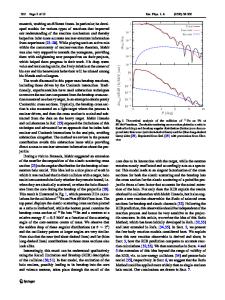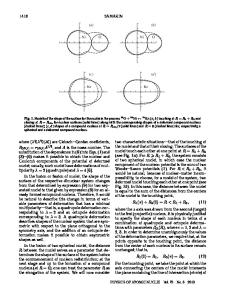Study of Resonant States in Halo Nuclei
A strategy for theoretical study of neutron halo nuclei is proposed: At the first stage (I), we solve a few-body problem of the core-plus-neutron model assuming a single frozen configuration for the core cluster. At the second stage (II), we take into acc
- PDF / 27,052,037 Bytes
- 319 Pages / 504.6 x 720 pts Page_size
- 20 Downloads / 322 Views
T
FAw-
ljociv
Systems Editor in Chief: W Plessas, Graz
Supplement 13
Resonances in Few-Body Systems Proceedings ofthe International Workshop) Sdrospatak) Hungary, September 4-8) 2000
Edited by A. T Kruppa and R. G. Lovas
SpringerWienNewYork
Dr. Andras T. Kruppa Dr. Rezso G. Lovas Institute of Nuclear Research Hungarian Academy of Sciences Debrecen, Hungary
Printing was supported by the Bundesministerium fUr Bildung, Wissenschaft und Kultur, Wien, Austria
This work is subject to copyright. All rights are reserved, whether the whole or part of the material is concerned, specifically those of translation, reprinting, re-use of illustrations, broadcasting, reproduction by photocopying machines or similar means, and storage in data banks. © 2002 Springer-VerlagIWien
Product Liability: The publisher can give no guarantee for all the information contained in this book. This does also refer to information about drug dosage and application thereof. In every individual case the respective user must check its accuracy by consulting other pharmaceutical literature. Typesetting: Camera-ready by authors Printing: Druckerei Novographic, A-1230 Wien Binding: Papyrus, A-l1 00 Wien Printed on acid-free and chlorine-free bleached paper SPIN: 10856958
With 115 Figures
CIP data applied for
ISSN 0177-8811
ISBN 3-211-83766-3 Springer-Verlag Wien New York
Organizing Committee
V.B. Belyaev J. Darai B. K6nya A.T. Kruppa R. G. Lovas (chairman)
J.Zs. Mezei Z. Papp J. Revai W. Sandhas T. Vertse
International Advisory Committee
W. Domcke (Munich) W. Glockle (Bochum) C. Green (Colorado) Y.K. Ho (Taipei) R.J. Liotta (Stockholm) J. Macek (Oak Ridge) W. Plessas (Graz) J.M. Richard (Grenoble) D.O. Riska (Helsinki) S.L. Yakovlev ( St. Petersburg) T. Yamazaki (Tokyo)
Sponsors
The United Nations Educational, Scientific and Cultural Organization, ROSTE, Venice Office State Secretary, Ministry of Education, Hungary National Fund for Scientific Research, Hungary MOL, Hungarian Oil Company Research & Development Division, Ministry of Education, Hungary International Centre for Workshops on Theoretical Physics, Budapest Hungarian Academy of Sciences Rexpo Ltd" Debrecen
Foreword
This volume contains the proceedings of the International Workshop on Resonances in Few-Body Systems held in Sarospatak, at the Tokaj wine area, Hungary, from 4 to 8 September, 2000. Resonances belong to the most widespread natural phenomena. They occur in systems ranging from macroscopic elastic bodies to systems of elementary particles. Any system that has eigenfrequecies and is coupled to its environment can show resonances. A resonance may be considered an eigenstate of a system. Although it has a finite life-time, the eigenstate concept can be formulated precisely even in quantum mechanics, as a kind of generalization of the quantum mechanical notion of an eigenstate. The very word 'eigenstate' suggests that the properties of these states are characteristic of the system itself: of its composition, size, number of degrees of freedom, excitation mecha











